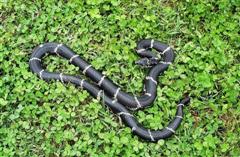Kingsnake - Eastern
Eastern King Snake, Chain Kingsnake, Chain King Snake Scientific Name: Lampropeltis getula getula
Sat, 19th July, 2025 - 2:40 am GMT
Sponsor Ads:

Alternative Name
Eastern King Snake, Chain Kingsnake, Chain King Snake Scientific Name: Lampropeltis getula getulaBasic Info
The Eastern Kingsnake is black, though sometimes brown shades are seen, with 20 to 45 white to yellow cross bands along its body and tail. The pattern is often described as chain-like hence their other name "Chain Kingsnake". They are larger than some other kingsnake species, ranging from three to six feet in length at maturity. Their heads and bellies are also black to brown with lighter colored markings.
Health
The Eastern Kingsnake is not difficult to care for. They should be kept at temperatures around 75 to 85 degrees Fahrenheit, with moderate humidity. Breeding The Eastern Kingsnake usually breeds in the spring or early summer between May and June. Eastern Kingsnakes generally lay anywhere from 6 to 26 eggs between June and August. Incubation lasts 55 to 62 days, with hatchlings measuring eight to twelve inches in length. To induce breeding in captivity, the temperature should be cooled down between 50 and 60 degrees Fahrenheit for a two to three month period.Habitat
Seen in a variety of different habitats from hardwood forests, to swamps, to more populated areas such as farmlandsBehavior
The Eastern Kingsnake is a hardy snake that is easy to keep and fairly common, making it a good choice among beginning hobbyists. The Eastern Kingsnake is an adaptable snake that is seen in a variety of different habitats from hardwood forests, to swamps, to more populated areas such as farmlands. They are also known to eat a variety of different foods including birds, lizards, frogs, toads, rodents, eggs, and other snakes. Like many other kingsnakes, the Eastern Kingsnake is known to eat some venomous snakes. The Eastern Kingsnake is generally considered to be a secretive species, not as commonly seen in the wild as some other kingsnakes. Though Eastern Kingsnakes are generally most active in the daytime, some are also known to be active at night, particularly when it is extremely hot during the day. The Eastern Kingsnake is known to do quite well in captivity, as it is a hardy, long-lived snake that is not difficult to feed. For this reason they are good snakes for beginners as well as more experienced hobbyists.Origin
North AmericaHistory
The Eastern Kingsnake is native to the Eastern United States, as far north as southern New Jersey and as far south as northern Florida. Their preferred habitat includes pinelands, oak hammocks, hardwood forests, bottomlands, tidal wetlands and swamps, and they are also seen in populated areas such as farmlands.Common Foods
feeds on lizards, birds, snakes, eggs, frogs, lizards and small mammalsSponsor Ads:
"Hence to fight and conquer in all your battles is not supreme excellence; supreme excellence consists in breaking the enemy's resistance without fighting." -- Sun Tzu, The Art of War
Kingsnake - Eastern
Coded by: BGID® | ALL RIGHTS RESERVED Copyright © 2000-2025
Disclaimer | Privacy | Report Errors / Contact | Credits


 Preparing For China. China is growing their military. China Military Technology - can it keep up with the US?
Preparing For China. China is growing their military. China Military Technology - can it keep up with the US?  versus
versus 

 versus
versus 
 This Thread is about the North Korean Military itself - the kind of army, navy, and air force they have.
This Thread is about the North Korean Military itself - the kind of army, navy, and air force they have. 
 versus
versus 
 versus
versus  versus
versus